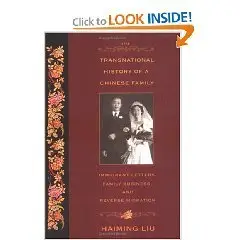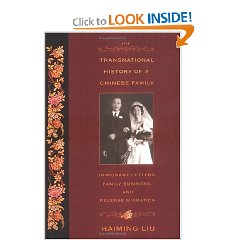The Transnational History Of A Chinese Family: Immigrant Letters, Family Business, And Reverse Migration
by: Haiming Liu | Rutgers University Press | 2005 | ISBN 0813535972 | Pages 257 | PDF | 1.2 MB
"An important history of Chinese American transnationalism, the book provides valuable insights into lesser known aspects of these immigrant lives, and allows us to understand Asian American history through the well-documented experiences of a family."—Yong Chen, author of Chinese San Francisco, 1850–1943: A Transpacific Community
"This brilliantly nuanced story . . . challenges us to rethink immigration and immigrant adaptation in the broader cross-cultural and transnational milieu."—Min Zhou, Inaugural chair of the Department of Asian American Studies at the University of California, Los Angeles
Family and home are one word—jia—in the Chinese language. Family can be separated and home may be relocated, but jia remains intact. It signifies a system of mutual obligation, lasting responsibility, and cultural values. This strong yet flexible sense of kinship has enabled many Chinese immigrant families to endure long physical separation and accommodate continuities and discontinuities in the process of social mobility.
Based on an analysis of over three thousand family letters and other primary sources, including recently released immigration files from the National Archives and Records Administration, Haiming Liu presents a remarkable transnational history of a Chinese family from the late nineteenth century to the 1970s. For three generations, the family lived between the two worlds. While the immigrant generation worked hard in an herbalist business and asparagus farming, the younger generation crossed back and forth between China and America, pursuing proper education, good careers, and a meaningful life during a difficult period of time for Chinese Americans. When social instability in China and a hostile racial environment in America prevented the family from being rooted in either side of the Pacific, transnational family life became a focal point of their social existence.
This well-documented and illustrated family history makes it clear that, for many Chinese immigrant families, migration does not mean a break from the past but rather the beginning of a new life that incorporates and transcends dual national boundaries. It convincingly shows how transnationalism has become a way of life for Chinese American families.
Review:
"An important history of Chinese American transnationalism, the book provides valuable insights into lesser known aspects of these immigrant lives, and allows us to understand Asian American history through the well-documented experiences of a family." - Yong Chen, author of Chinese San Francisco, 1850-1943: A Transpacific Community"



